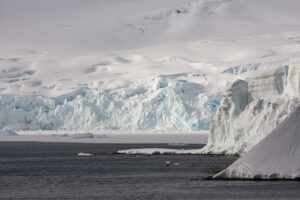On a January 2022 morning in the Southern Ocean, the air was so thick with condensing whale breath you’d have to clean your glasses to see what surrounded you.
And you’d want to do it. That day, an aggregation of around 1,000 whales swarmed into waters just off the Antarctic Peninsula to feed on a dense shoal of krill.
Passengers and crew on board the cruise ship National Geographic Endurance experienced the sighting. The vessel’s namesake publication said that no one had witnessed such a scene since industrial whaling nearly drove the species to extinction.
Fin whales comprised most of the group, along with a few humpbacks and blue whales, Nat Geo said. Fin whales are the second-biggest animals on earth. Only blue whales outsize them. They can swim at a swift 45kph and eat 2,000kg of krill daily.
A r
A rare species
Conor Ryan, a zoologist and resident naturalist on the ship, described the atmosphere at the rare sighting.
“Once we got closer, the sound of blowing from the whales was continuous and all around us, as was condensing whale breath in the air, which required regular cleaning of our camera lenses and sunglasses,” Ryan told National Geographic, also calling the scene “beyond belief.”
Ryan is also co-author of a paper approved for publication this week under the Ecological Society of America that tackles a sadder aspect of the sighting: Several commercial fishing vessels were actively trawling for krill through the group of whales at the time.
Fin whales suffered heavily under industrial whaling, which remained a contentious topic worldwide through the end of the 20th century. The International Whaling Commission (IWC), which manages global whale conservation, first formed in 1946 but didn’t start issuing bans on whaling until a few decades later. Whaling became illegal in Antarctica in 1994.
By that time, though, humans had almost hunted fin whales out of existence. National Geographic estimated the animals’ population peaked at around one million individuals, but “a century of whaling reduced their numbers by roughly 98 percent.”

A fin whale, second-largest animal on the planet. Photo: Aqqa Rosing-Asvid via Wiki Commons
A growing population but still vulnerable
The good news is that the International Union for Conservation of Nature says that fin whales are growing in number — though still vulnerable to extinction.
It’s unclear what the enormous gathering that the cruise ship stumbled upon indicates regarding the species’ well-being. Because of their dietary preference for heavily fished krill, ship strikes and entanglement in fishing gear threaten fin whales.
A humpback whale, likely lured by a trawling net capturing masses of Antarctic krill, became entangled last month and died in the Southern Ocean. Three dead juveniles were caught in the same company’s krill nets last year. https://t.co/QrmgajWgeC
— Reuters Science News (@ReutersScience) February 24, 2022
Global demand for krill is growing fast. So a conflict looms: As fin whales continue to rebound, they’ll find themselves competing with fishing operations more closely.
Antarctica’s regulatory body for fishing is the Convention on the Conservation of Antarctic Marine Living Resources (CCAMLR), an international coalition. According to the British Antarctic Survey, its main objective in fishery management is to maintain healthy ecosystems, emphasizing “the ecological relationships between harvested populations and dependent species.”
As that relates to whales feeding on krill, it’s a work in progress. As of June 2022, CCAMLR set krill fishing limits at just 1% of what’s considered sustainable while it conducts an effort to “spatially subdivide the krill catch to minimize any adverse impacts upon krill predators.”
The new study co-authored by Ryan remained in final edit status as of this writing. The outcome of the encounter between the fin whale supergroup and the krill fishing operations, if any, remains unclear. The paper concerns “human-wildlife conflict” and conservation, among other key topics.






